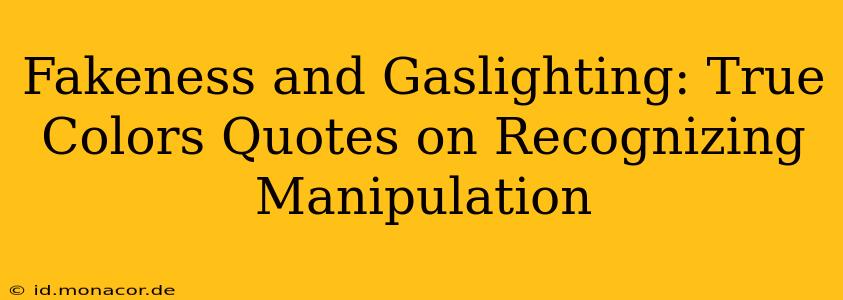Gaslighting and fakeness are insidious forms of manipulation that can wreak havoc on your mental and emotional well-being. Identifying these behaviors is crucial for protecting yourself and setting healthy boundaries. While there's no single "True Colors" test to definitively identify manipulators, understanding the characteristics of these behaviors, recognizing red flags, and learning to trust your intuition are key. This article will explore the signs of fakeness and gaslighting, offering insights based on common experiences and observations, similar to how a "True Colors" approach might highlight personality traits. We'll examine how to identify these behaviors and protect yourself from their damaging effects.
What is Gaslighting?
Gaslighting is a form of psychological manipulation where someone makes you question your own sanity and perception of reality. The manipulator subtly alters your perception of events, making you doubt yourself and trust their version of the truth, even when it contradicts what you know to be true. This can lead to confusion, self-doubt, and a diminished sense of self-worth.
What are the Signs of Fakeness?
Fakeness manifests in various ways. Individuals displaying fake behavior often present an idealized version of themselves, hiding their true intentions and emotions. They may:
- Project a false persona: They may present a different personality in different settings, adapting their behavior to impress others.
- Exaggerate accomplishments: They may inflate their achievements or skills to appear more impressive.
- Lack genuine empathy: They struggle to understand or share the feelings of others.
- Engage in superficial flattery: Their compliments feel insincere and self-serving.
- Constantly seek validation: They require constant reassurance and approval from others.
How to Identify Gaslighting
Identifying gaslighting can be challenging, as it's often subtle and insidious. However, some common signs include:
- Denial of reality: The manipulator denies events that actually occurred, making you question your memory and perception.
- Trivializing your feelings: Your emotions and experiences are dismissed as unimportant or overblown.
- Shifting blame: Responsibility for problems or mistakes is always shifted onto you.
- Using guilt and shame: You're made to feel guilty or ashamed for expressing your concerns or needs.
- Isolation: The manipulator may try to isolate you from friends and family who might offer support or a different perspective.
What are some examples of gaslighting in a relationship?
Gaslighting in a relationship can manifest in many ways, often subtly. For instance, a partner might deny saying something they clearly said, or twist events to make you feel like you're the one at fault in an argument. They might constantly criticize your decisions, making you doubt your judgment. Another example is when a partner undermines your accomplishments or belittles your feelings, making you feel insignificant.
How can I tell if someone is being fake with me?
Trust your gut feeling. If something feels off about someone's behavior or interactions, it likely is. Pay attention to inconsistencies in their words and actions. Do their actions match their words? Do they treat others differently than they treat you? Do they consistently seek validation? These are all signs of potential fakeness.
What are the consequences of gaslighting and being around fake people?
The consequences of prolonged gaslighting can be severe, leading to anxiety, depression, low self-esteem, and difficulty trusting others. Being around fake people can leave you feeling drained, used, and emotionally depleted. It can erode your sense of self and make it harder to form healthy relationships.
How can I protect myself from gaslighting and fake people?
Protecting yourself requires awareness, assertiveness, and establishing healthy boundaries. Learn to recognize the signs of gaslighting and fakeness. Trust your intuition and don't be afraid to challenge the manipulator's version of events. Surround yourself with supportive people who validate your experiences and feelings. Set clear boundaries with those who try to manipulate you. Seek professional help if you're struggling to cope with these behaviors.
Conclusion
Recognizing fakeness and gaslighting is crucial for safeguarding your emotional and mental well-being. By understanding the signs, trusting your intuition, and setting healthy boundaries, you can protect yourself from manipulative individuals and create healthier relationships. Remember, you deserve to be treated with respect and have your reality acknowledged. If you suspect you're experiencing gaslighting, seeking support from a therapist or counselor can provide valuable guidance and support.

